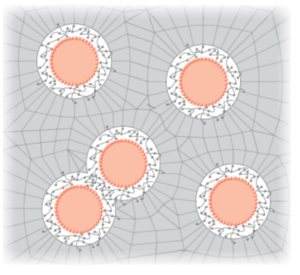Polymer nanocomposites
Mechanical properties of the interphase in polymer-based nanocomposites
In engineering applications, plastics play an important role and offer new possibilities to achieve and to adjust a specific material behavior. They consist of polymer chains and possess, together with additives, an enormous potential for tailored properties.
Recently, techniques have been established to produce and to disperse filler particles with typical dimensions in the range of nanometers. Even for low volume contents of filler particles, these so-called nanofillers may have significant impact on the properties of plastics. This can be most likely traced back to their very large surface-to-volume ratio. In this context, the polymer-particle interphase is of vital importance: as revealed by experiments, certain nanofillers may e.g. increase the fatigue lifetime of plastics significantly.
The appropriate design of such nanocomposites quite frequently requires elaborated mechanical testing, which might – if available – be substituted or supplemented by simulations. For this purpose, however, continuum mechanics together with the Finite Element Method (FEM) as the usual tool for engineering applications is not well-suited since it is not able to capture processes at the molecular level. Thus, particle-based techniques such as Molecular Dynamics (MD) have to be employed. However, these typically allow only for extremely small system sizes and simulation times. Thus, a multiscale technique that couples both approaches is required to enable the simulation of, e.g., representative volume elements (RVE) under consideration of atomistic effects.
 Figure 1: Multiscale setup of a polymer nanocomposite: filler particles (red), interphase region at atomistic resolution (white), and pure polymer matrix (grey)
Figure 1: Multiscale setup of a polymer nanocomposite: filler particles (red), interphase region at atomistic resolution (white), and pure polymer matrix (grey)
The goal of this project is the development of a methodology which yields a continuum-based description of the material behavior of the polymer-particle interphase of nanocomposites, whereby the required constitutive laws are derived from particle-based simulations. Due to their very small dimensions of some nanometers, the interphases cannot be accessed directly by experiments and it is thus desirable to substitute mechanical testing by particle-based simulations. The Capriccio method, designed as a simulation tool to couple MD and FE descriptions for amorphous systems, will be employed and refined accordingly in the course of the project.
In the first step, the mechanical properties of the polymer-particle interphase shall be determined by means of inverse parameter identifications for small systems with one and two nanoparticles. In the second step, these properties shall be transferred to large RVEs as sketched in Fig. 1. With this methodology at hand, various properties as e.g. the particles’ size and shape as well as grafting densities shall be mapped from pure particle-based considerations to continuum-based descriptions. Further consideration will then offer prospects to transfer the material description to applications relevant in engineering and eventually suited for the simulation of parts.
